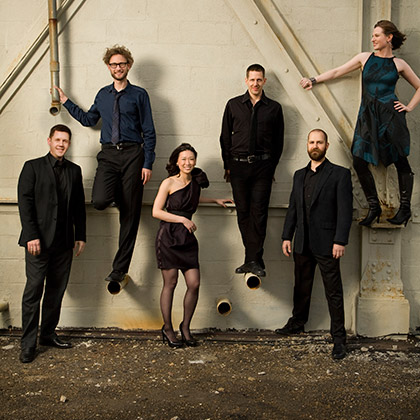
viii.
I know noble accents
And lucid, inescapable rhythms;
But I know, too,
That the blackbird is involved
In what I know.
Inspired by the eighth stanza of Wallace Stevens’ “Thirteen Ways of Looking at a Blackbird” – indeed the Chicago-based sextet picked up the evocative feel of the poem. But I know, too, that some other magical, indescribable element is involved to make eighth blackbird what it is: talent and innovation.
One major element of blackbird’s contemporary style is dissonance, that moment when two notes clash against each other and you find yourself cringing a little. But the beauty of dissonance is that it’s an effortless effort to make someone appreciate the following note that shifts seamlessly into harmony. Without the dissonance, would we notice the climactic, chord-changing note that sets it all right? It’s hard to say. But eighth blackbird calls our attention to it.
My favorite piece was an original composition by the ensemble’s pianist, Lisa Kaplan. Entitled “whirligig for piano four hands,” it centers around spinning, chaos, and the circular movement of change. Not only did I fall in love with the whimsical title, I was intrigued by the concept of “four hands,” which I soon discovered means that two people play side-by-side on the same piano. The piece was divided into three movements. The first, “off-kilter,” showed a playful fight for a space between musicians. The two pianists stretched their arms up and under each others to reach the key just beyond their reach, resulting in a hilarious theatrical spar. Until truly, the bench itself was off-kilter and one of the pianists proved victorious by taking command of the entire piano, leaving the other, with no space of her own, reluctantly getting up from the bench. This, of course, marked the end of the piece, because you can’t play a piece for four hands without four hands! The second movement, “merry-go-round,” tinkled with the wound-up gracefulness of a jewelry box. I found myself closing my eyes as I was gently lulled into the peaceful recurring theme. Around the carousel we went…with childlike nostalgia…back into time…with this lullaby as our road trip soundtrack. In complete contrast, the third movement, “boogie-woogie,” showcased the body’s innate desire to jive. This was the ultimate jazz piano piece with all kinds of movement – foot thumping, body-rocking, head-banging, and most unusually, elbow-playing! Using the flat part of their forearms, the two pianists smashed their arms down on the keys in syncopated rhythms. Contrary to the expected “bull in a china shop” result, these spontaneous bursts of sound energized the background melody in a surprisingly refreshing way. It just shows that perhaps a little chaos in our life keeps us, well, on our elbows!
The ensemble proved that they weren’t afraid to bend the rules of music. Another spectacular part of their show was their performance of “Counting Duets” by Tom Johnson. Using only their voices and clapping hands, the musicians used numbers as a lyrical conversation. For example, two voices approached each other and alternated with : “1.” “2, 3.” “4?” “2.” “6!” “6?” and so on. But the magnificence wasn’t in the numbers, it was in the inflections, the tones, the way that the voices put on a theatrical conversation without using any words at all. It made me start to think about what music is…was this music? Just a bunch of people manipulating the way their voices said numbers? And then I realized. Yes. It was. Music, after all, is the artistic culmination of science, physics, and math, in its basic counting form. To emphasize the musicality of numbers and counting, eighth blackbird alternated between these vocal counting duets and romantic instrumental etudes by Gyorgy Ligeti; in the end, they mastered both the external and internal counting machines of music. And, more importantly, they’ve mastered the blackbird.

